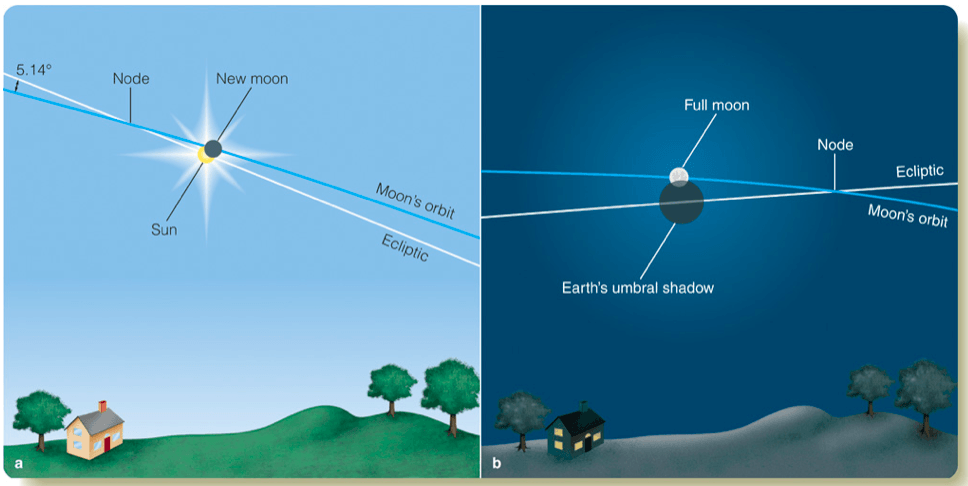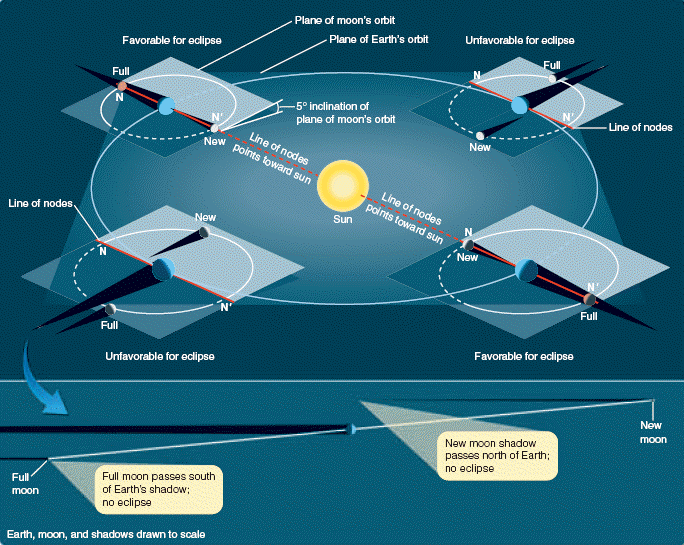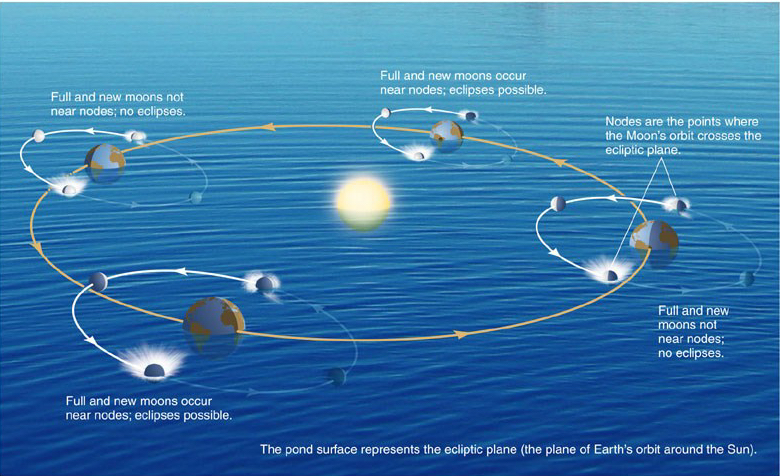

There can be no doubt that solar and lunar eclipses are some of the most fascinating sights for the “naked” eye. (And I say “naked” under the assumption that you know never to look directly at the sun without approved protection!)
Unless it’s during totality. Then you can take those glasses off.
But what I mean is, solar and lunar eclipses don’t require telescopes or binoculars to be seen. You don’t need to use any special equipment. You just need your eyes, and in the case of a solar eclipse, some form of protection—like solar glasses.
You may have noticed that when a solar eclipse comes up—or even a lunar eclipse—it’s all the rage. Suddenly, the media is swamped with safety warnings and calendar countdowns to the big event.
The United States just about lost its mind over the solar eclipse of August 21, 2017. And I have a feeling the next total solar eclipse to pass over the US, in seven years, will be just as dramatic.
But you might also be wondering…how do we know when these incredible sights are going to happen?
There’s something called eclipse “seasons.”
And no, they’re not like Earth’s four seasons. We don’t get a winter, spring, summer or fall for eclipses. What we do get are specific times during each year when an eclipse can happen.
And if you think about it, a season is a specific interval during the year when certain weather tends to happen. So the name makes sense.
By understanding the orbits of the moon and the Earth, we can better understand when we might be graced with the path of totality.
But first, let’s talk about nodes.
You might be aware that the moon’s orbit doesn’t line up with the ecliptic (the Earth’s orbit).

It’s tilted about 5° off the ecliptic. This is why we don’t get solar and lunar eclipses every month. If the orbits were lined up perfectly, eclipses would happen every time the moon was new or full—twice every single month!
But that’s not what happens. Now, remember how I said that the ecliptic refers to Earth’s orbit? It also refers to the paths the other objects follow across the sky from our point of view on the surface.
That means that in the sky above you, the moon’s path across the sky will be tilted just 5° off the ecliptic.

Nodes are what we call the imaginary points in the sky where the ecliptic and the moon’s orbit cross.
This diagram shows partial solar and lunar eclipses. Notice that for the observer here to see total eclipses, the moon would have to move entirely in front of the sun—or the moon would have to cross entirely through the Earth’s umbral shadow.
And in order for the moon to cross the sun, or for the Earth’s shadow to fall over the moon, the sun and the moon both need to be at one of the nodes.
Wait a second, one of the nodes? So where are the two nodes?

There is a node on each opposite side of the moon’s orbit, where it crosses through the ecliptic plane. Astronomers call one node the ascending node and the other the descending node, but that’s not really important.
During a solar eclipse, in order for the moon to cover the sun, both need to be at the same node—meaning, the moon needs to be between the Earth and the sun.
But during a lunar eclipse, the sun and moon need to be at opposite nodes. That way, the sun’s light will let the Earth cast a shadow on the opposite node, and because the moon is there, it will be eclipsed.

This diagram shows the Earth and the moon at different stages of the Earth’s orbit. As you can see, the moon’s orbit stays at the same angle to the ecliptic. But as the Earth moves around the sun, sometimes the nodes line up.
We call the imaginary line from one node to the other the line of nodes. This line needs to point at the sun in order for an eclipse to happen.
The smaller diagram here shows the moon and Earth to scale (even the moon’s distance from us). You can see why the nodes need to line up perfectly. The shadows are so long and thin that it’s easy for them to miss their target.
If it helps, think of the Earth’s orbit as resting on the surface of a pond. The moon’s orbit, though, is tilted so it stays halfway submerged.

As the moon orbits the Earth, it surfaces and then dives underwater again. In order for an eclipse to happen, the moon has to be exactly on the surface—and the moon, Earth, and sun have to line up exactly!
Any point where the moon rests exactly on the surface of the water is a node, because its orbit has just crossed the ecliptic. But the sun has to be at a node in the sky, too, for an eclipse to happen. That’s why the line of nodes has to point at the sun.
When the sun is near a node in the sky, we call it an eclipse season. An eclipse season lasts about 32 days for a solar eclipse. Notice that this time is longer than a month. This means there’s a pretty good chance the moon will be new during this time, and a solar eclipse will happen.
An eclipse season lasts only about 22 days for a lunar eclipse, but this time is still long enough for there to be a high chance of a full moon. And if that happens, there will be a lunar eclipse.
Now, this perfect system doesn’t stay exactly perfect. The moon’s orbit wobbles just a tiny bit, kind of like a hubcap spinning on the ground. This motion is called precession.

This changes when the moon breaks the surface of the pond during its orbit. And it will mean that the Earth will have to be at a slightly different place in its orbit for the line of nodes to point at the sun.
However, this doesn’t change things dramatically. In fact, it means that the sun doesn’t take a full year to start at a node, move around Earth’s sky, and then come back to the same node again. It only takes about 346.6 days.
This length of time is called an eclipse year.
What this means is that every 346.6 days, there will be an eclipse season for 22-32 days. And any new or full moon during that time will give us an eclipse.
I had planned this post to be my last on eclipses, but there’s one more topic left to talk about—the saros cycle. This cycle is very helpful in predicting eclipses, so I’ll cover it in one more post.
I had never thought about eclipse seasons before, but it makes a lot of sense ☺️
LikeLiked by 1 person
I know, right? 🙂 Most science makes sense if you frame the concepts in the right way. If I didn’t believe that, there’d be no point to this blog 🙂
LikeLike
That’s fine, but what happens when science ends out? I can’t neither all we are is a pile of chemicals. She physically we are, but we’re far more than that I think. That’s the but that science can’t answer alone ☺️
LikeLiked by 1 person
We just haven’t figured out the “spark” of life yet. Mysterious things happen at the quantum level and I’ll bet one day it’ll explain life. The idea that science will “end out” is as much a paradigm as is the idea that science can explain everything.
LikeLike
I know but am I really just the sum of quantum physics? I guess we might never know…
LikeLiked by 1 person
I would query, then, whether the sum of quantum physics is “just” anything. My trust in science leads me to postulate that something at the quantum physics level grants us not just intelligence, but sentience. And that sentience fuels itself—religion, in my opinion, is just speculation fueled by sentience, while science is actual fact and explains sentience. Might this idea of mine be proven wrong eventually? Of course, and I’ll readily accept that. We just don’t know yet 🙂
LikeLike